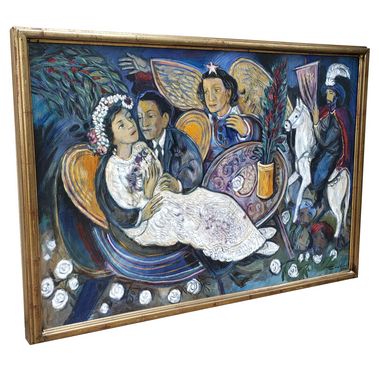A poignant masterpiece by the distinguished Michoacán artist, Juan Torres, signed and dated in 2012. This oil painting on canvas immerses us in a scene that transcends time and space to explore profound themes of love, loss, and spirituality.
At the center of the composition, we find the figure of a young deceased woman dressed in white, crowned with flowers, and embraced by a loved one. The intensity of emotion in this scene is palpable as the viewer witnesses the farewell between earthly life and the afterlife. Her guardian angel, identifiable by the star on its head, patiently waits to guide the soul of the departed to heaven, providing comfort and hope amidst grief.
On the right side of the painting, the figure of Santiago Matamoros, the patron saint of Spain, points towards the sky. This celestial warrior is depicted on horseback, carrying a standard and surrounded by three heads of defeated Moors at his feet. His presence adds a spiritual and protective dimension to the scene, suggesting that the soul of the departed is being escorted to eternal peace.
This heavenly farewell painting transcends words and delves into the depths of the human experience. Juan Torres' mastery is reflected in every brushstroke and detail, and his ability to convey emotions and spirituality through painting is truly remarkable.
The veneration of the Guardian Angel is a deeply rooted part of our culture, both in Mexico and many other parts of the world. It is believed that each person has a Guardian Angel assigned to them from the moment of birth, a celestial being that protects and guides us throughout our life. In times of difficulty or danger, many people turn to prayer and devotion to their Guardian Angel for protection and guidance. This profound spiritual connection is reflected in this artwork, where the Guardian Angel plays a crucial role in the transition of the deceased to eternal life.
Saint James, depicted in the painting, is a figure with rich symbolism in art. Besides being the patron saint of Spain, he is known as Santiago Matamoros, with 'Mata-moros' referring to his supposed divine intervention in the Battle of Clavijo against the Moors in the 9th century. In art, his representation on horseback with a standard and the heads of defeated Moors at his feet is emblematic and has been used to symbolize the victory of the Christian faith over the enemies of Christianity.
The cult of death is a significant part of Mexican culture and is especially celebrated on the Day of the Dead, a holiday that honors deceased loved ones. This special relationship with death is not based on fear but on the belief that death is a natural part of life and that the departed continue to exist in the spiritual world. This painting can be considered in this context as it addresses themes of transition to the afterlife and the constant presence of spirituality in Mexican culture.

Juan Torres
(1942)
Born in Morelia Michoacan, Mexico, Torres started drawing and painting at the age of 7. He was a student at the Universidad de Morelia and by his 9th birthday he started studying with the great Mexican Muralist Alfredo Zalce. He was his pupil for over 20 years. He has built houses and haciendas as an architect as well as becoming a great teacher of painting and sculpture. His cane paste and clay seminars are famous in Mexico. "I gave a class at the Escuela Popular de Bellas Artes at the Universidad de Michoacan when I met Juan Torres. He was very young but very soon he became one of my best students working with ceramics, silver, sculpture, drawing and painting. He was very dedicated and always got good grades. His art matured when he graduated from school. He always got good reviews from critics and art connoisseurs. I let him go to help him develop a unique style. School gave him the means to become successful but he went on from there. My work was to give him the little knowledge that I have."
Alfredo Zalce, August 1995.

